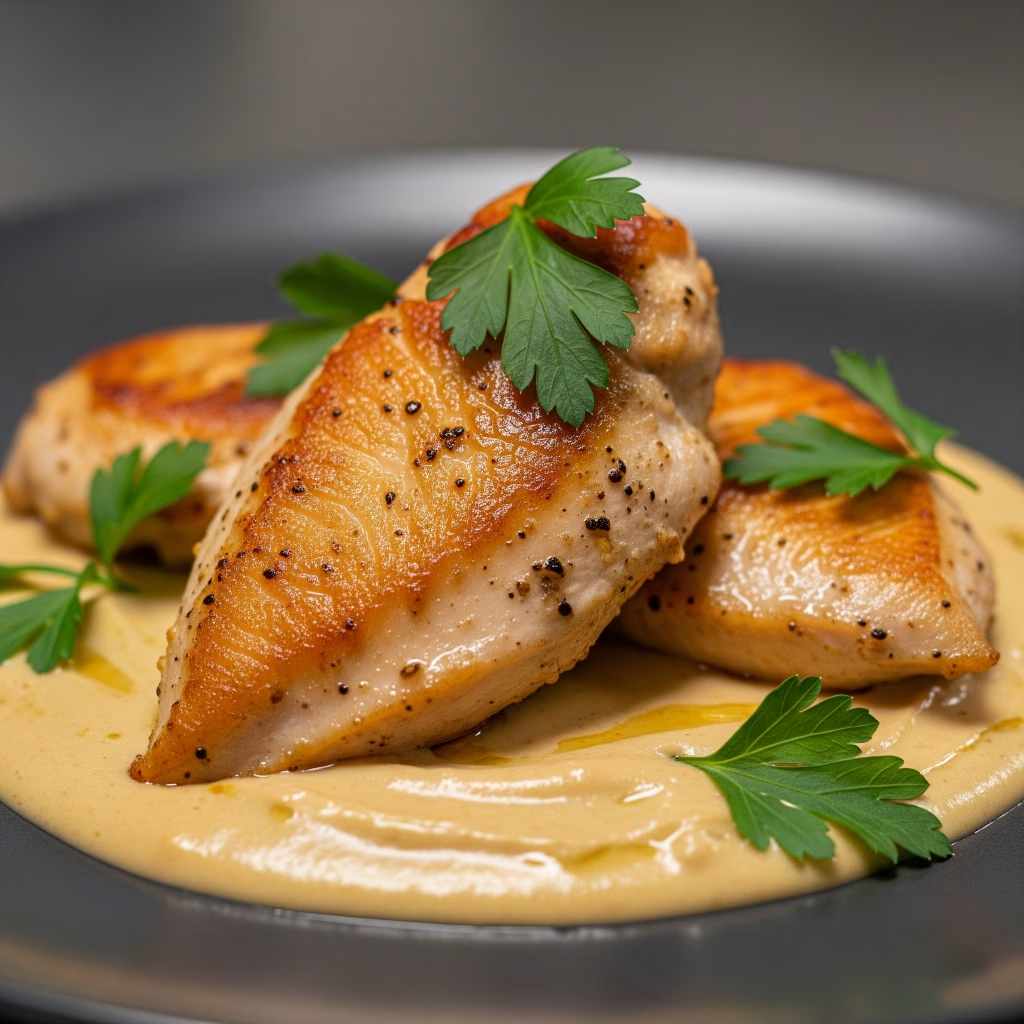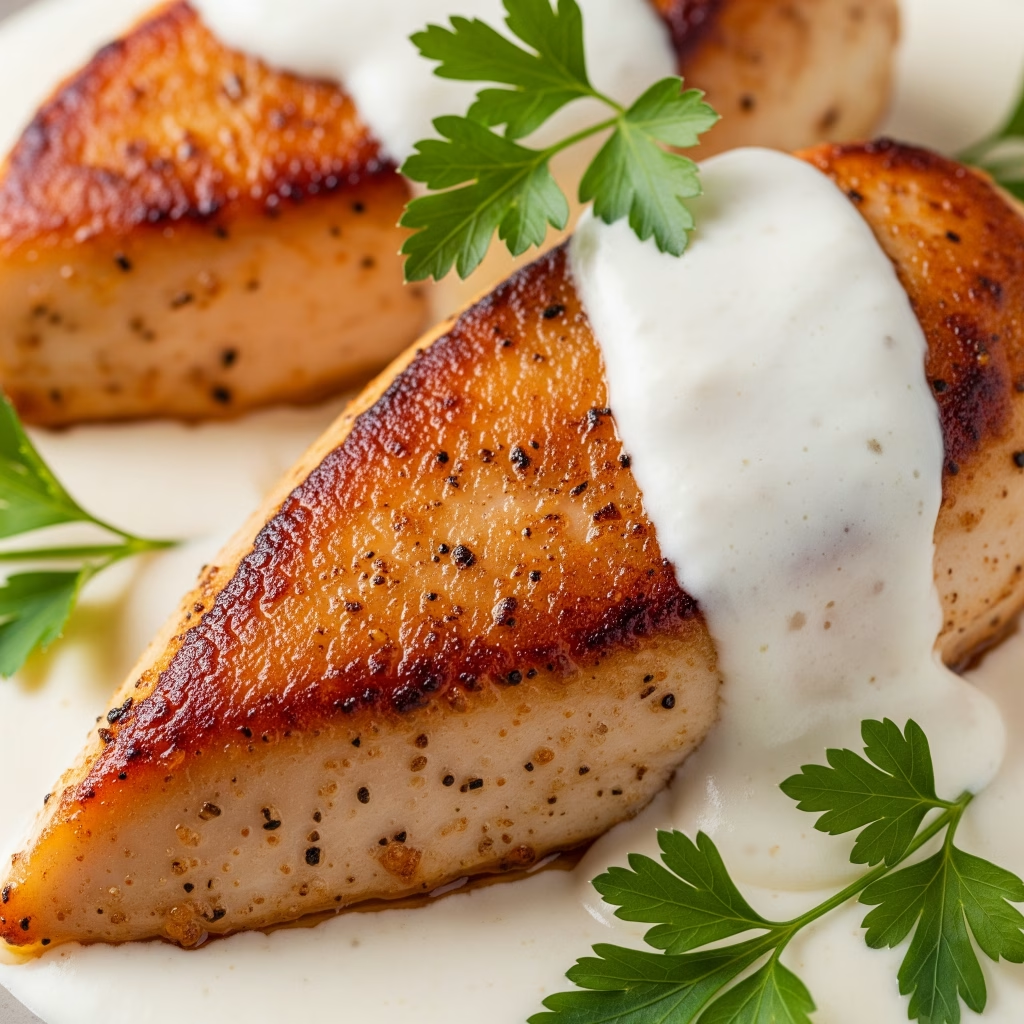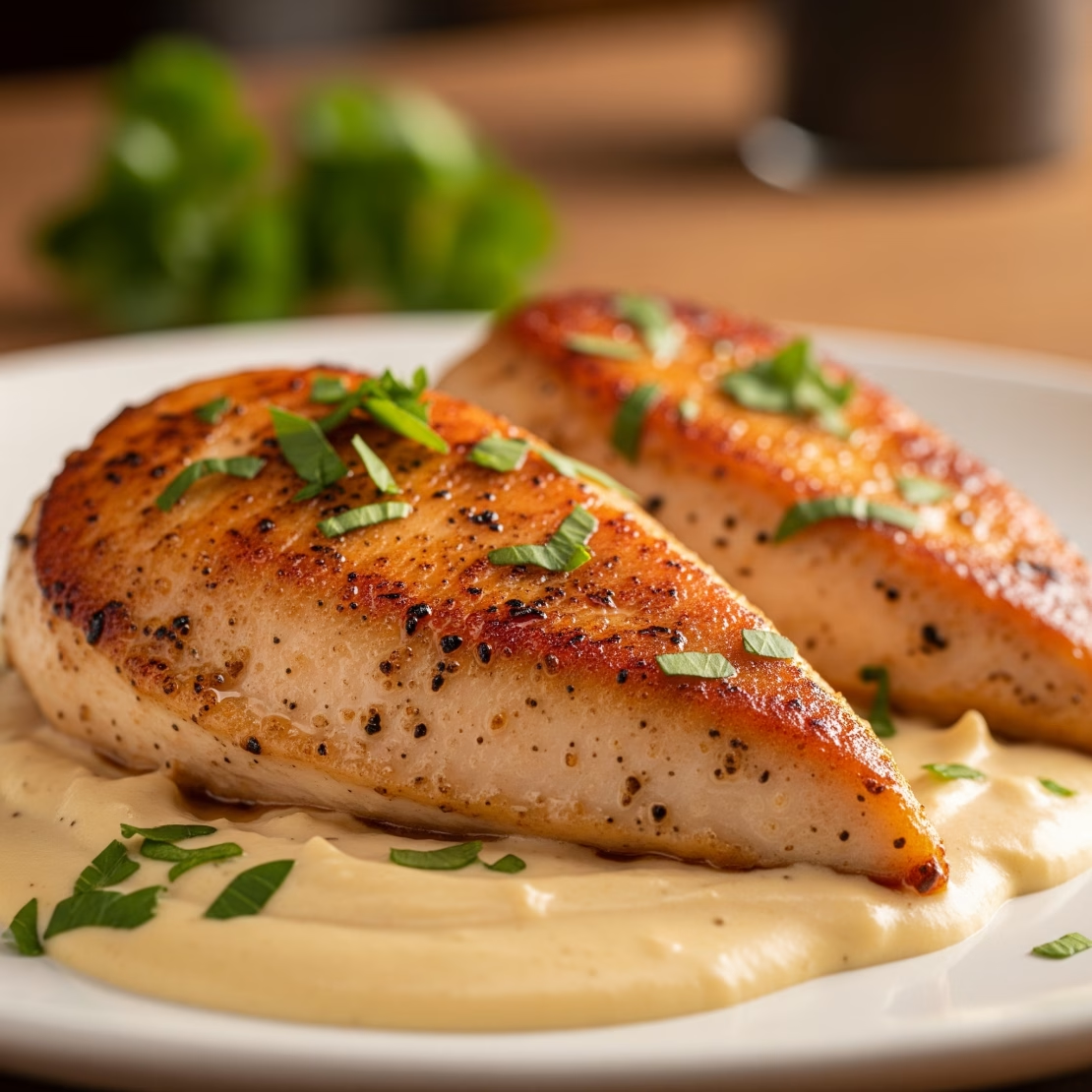Chicken Fillet à is a versatile and delicious dish that can be prepared in various ways to suit different tastes and occasions.
This classic recipe emphasizes succulent chicken fillets cooked to perfection with a rich, flavorful sauce. Whether you are planning a simple family dinner or a special occasion meal, this dish is sure to impress.
We’ll guide you through everything you need to know to make Chicken Fillet à, including a detailed recipe with step-by-step instructions, serving suggestions, tips for perfection, healthier alternatives, creative variations, common mistakes to avoid, and even a bit of history.
So let’s dive into the world of culinary delight with Chicken Fillet à!
Table of Contents
Ingredients
To make Chicken Fillet à, you’ll need the following ingredients. These quantities are designed to serve 4 people, but you can adjust them according to your needs.
Ingredients List
- 4 boneless chicken fillets
- Look for high-quality, fresh chicken breasts. You may also choose chicken thighs if you prefer a juicier cut.
- 2 tablespoons olive oil
- This will be used for searing the chicken, giving it a lovely golden crust.
- Salt and pepper to taste
- Basic seasoning for enhancing the chicken’s natural flavor.
- 1 teaspoon garlic powder
- Adds a subtle garlic flavor that complements the chicken.
- 1 tablespoon butter
- Butter adds richness to the sauce, making it more flavorful.
- 1 cup chicken broth
- Provides a savory base for the sauce.
- 1/2 cup heavy cream
- Cream creates a silky, luxurious texture in the sauce.
- 1 teaspoon Dijon mustard
- Adds a tangy, spicy note to balance the creaminess.
- 1 teaspoon lemon juice
- Fresh lemon juice brightens the dish and adds a hint of acidity.
- 1 tablespoon chopped fresh parsley
- For garnish and added freshness.
- Optional: 1/4 cup white wine
- For deglazing the pan and adding depth to the sauce.
Step-by-Step Instructions
Here are the detailed instructions for preparing Chicken Fillet à. Follow these steps for a perfect dish every time.
Step 1: Prepare the Chicken Fillets
- Trim and Pound the Chicken:
- Trim any excess fat from the chicken fillets and pat them dry with paper towels.
- Place each fillet between two sheets of plastic wrap and pound gently with a meat mallet until they are about 1/2 inch thick. This helps in even cooking.
- Season the Chicken:
- Season both sides of the chicken fillets generously with salt, pepper, and garlic powder.
- Let them rest for a few minutes to allow the flavors to penetrate.
Step 2: Sear the Chicken
- Heat the Olive Oil:
- In a large skillet or frying pan, heat 2 tablespoons of olive oil over medium-high heat.
- Sear the Fillets:
- Place the seasoned chicken fillets in the hot pan. Do not overcrowd the pan; cook in batches if necessary.
- Sear for 4-5 minutes on each side until they are golden brown and cooked through. The internal temperature should reach 165°F (74°C).
- Remove and Rest:
- Once cooked, remove the chicken fillets from the pan and set them aside on a plate. Cover loosely with foil to keep warm.
Step 3: Prepare the Sauce
- Deglaze the Pan (Optional):
- If using white wine, pour it into the pan and scrape the bottom with a wooden spoon to deglaze. Let it simmer for a minute to reduce slightly.
- Melt the Butter:
- Add 1 tablespoon of butter to the pan. Allow it to melt, combining with any remaining olive oil.
- Add Chicken Broth:
- Pour in 1 cup of chicken broth and stir well to combine. Bring to a gentle simmer.
- Stir in Heavy Cream:
- Add 1/2 cup of heavy cream to the broth mixture, stirring constantly to create a smooth sauce.
- Incorporate Mustard and Lemon:
- Stir in 1 teaspoon of Dijon mustard and 1 teaspoon of lemon juice. Taste and adjust the seasoning with salt and pepper as needed.
Step 4: Combine and Serve
- Return Chicken to the Pan:
- Return the seared chicken fillets to the pan, spooning the sauce over them. Let them simmer for an additional 2-3 minutes to absorb the flavors.
- Garnish:
- Sprinkle with chopped fresh parsley before serving for a pop of color and added freshness.
- Serve:
- Plate the Chicken Fillet à with your choice of side dishes (see serving suggestions below).

Serving Suggestions
Chicken Fillet à is a versatile dish that can be paired with a variety of sides to create a complete meal. Here are some serving suggestions:
- Mashed Potatoes:
- Creamy mashed potatoes complement the rich sauce and make for a hearty meal.
- Steamed Vegetables:
- Lightly steamed vegetables like broccoli, asparagus, or green beans add color and nutrition.
- Rice Pilaf:
- A flavorful rice pilaf absorbs the sauce beautifully and provides a balanced texture.
- Pasta:
- Serve over a bed of pasta, such as fettuccine or penne, to create a comforting dish.
- Crusty Bread:
- Use crusty bread to soak up the delicious sauce, adding a rustic touch to your meal.
Presentation Tips
- Plating:
- Place the chicken fillet at the center of the plate, drizzling extra sauce around it. Arrange the sides attractively for a restaurant-style presentation.
- Garnishing:
- Garnish with lemon slices or fresh herbs for a professional look and added flavor.

Tips for Perfect Chicken Fillet à
Creating the perfect Chicken Fillet à involves attention to detail and a few key techniques. Here are some tips to ensure success:
Choosing the Right Chicken
- Breast vs. Thigh:
- While chicken breasts are lean and tender, thighs offer a juicier alternative. Choose based on personal preference.
- Freshness:
- Use fresh, high-quality chicken for the best flavor and texture. Frozen fillets should be thawed completely before cooking.
Searing the Chicken
- Preheat the Pan:
- Make sure the pan is hot before adding the chicken. This ensures a good sear and prevents sticking.
- Do Not Overcrowd:
- Cook in batches if necessary to maintain the pan’s temperature and achieve even browning.
- Use a Thermometer:
- A meat thermometer can help ensure the chicken is cooked to a safe internal temperature of 165°F (74°C).
Making the Sauce
- Cream Consistency:
- Whisk continuously when adding cream to prevent curdling and ensure a smooth sauce.
- Adjust Seasoning:
- Taste the sauce before serving and adjust seasoning as needed, especially if you’ve added wine.
Resting the Chicken
- Let it Rest:
- Allow the chicken to rest for a few minutes after cooking. This helps retain juices and makes the meat more tender.
Adding Personal Touches
- Experiment with Flavors:
- Try adding herbs like thyme, rosemary, or basil to the sauce for additional depth.
- Spicy Kick:
- For a bit of heat, add a pinch of red pepper flakes or cayenne pepper to the sauce.
Healthier Alternatives
If you’re looking to make Chicken Fillet à a bit healthier, consider these modifications:
Lower-Calorie Options
- Skip the Butter:
- Replace butter with olive oil to reduce saturated fat content.
- Use Light Cream:
- Substitute heavy cream with light cream or half-and-half for fewer calories.
- Reduce Salt:
- Use low-sodium chicken broth and reduce added salt for a heart-friendly version.
Dietary Modifications
- Gluten-Free:
- Ensure all ingredients, including mustard and broth, are gluten-free if required.
- Dairy-Free:
- Replace cream with coconut milk or almond milk, and use vegan butter for a dairy-free option.
Protein Alternatives
- Turkey Fillets:
- Substitute chicken with turkey fillets for a leaner choice.
- Tofu or Tempeh:
- For a vegetarian twist, use firm tofu or tempeh as the main protein source.
Creative Variations
Chicken Fillet à is a flexible dish that allows for endless creativity. Here are some innovative variations to explore:
Italian-Style Chicken Fillet à
- Add Tomatoes:
- Incorporate cherry tomatoes and fresh basil into the sauce for a Mediterranean flair.
- Parmesan Cheese:
- Sprinkle grated Parmesan cheese over the chicken before serving for a cheesy finish.
Asian-Inspired Chicken Fillet à
- Soy Sauce and Ginger:
- Add soy sauce, ginger, and sesame oil to the sauce for an Asian twist.
- Serve with Rice:
- Pair with jasmine rice and steamed bok choy for an authentic experience.
Spicy Cajun Chicken Fillet à
- Cajun Seasoning:
- Season the chicken with Cajun spices for a spicy kick.
- Bell Peppers:
- Add sautéed bell peppers and onions to the sauce for a Southern-style dish.
Lemon Herb Chicken Fillet à
- Lemon Zest:
- Add lemon zest and thyme to the sauce for a refreshing citrus flavor.
- Serve with Quinoa:
- Pair with quinoa and roasted vegetables for a light and healthy meal.
Common Mistakes to Avoid
Even the best chefs can make mistakes. Here are common pitfalls to watch out for when making Chicken Fillet à:
Overcooking the Chicken
- Keep an Eye on Time:
- Overcooked chicken becomes dry and tough. Use a timer and a meat thermometer to ensure it’s cooked perfectly.
- Monitor Heat:
- High heat can cause burning. Maintain medium heat for even cooking.
Sauce Separation
- Whisk Continuously:
- To prevent the sauce from separating, whisk continuously while adding cream and broth.
- Do Not Boil:
- Boiling can cause curdling. Keep the sauce at a gentle simmer.
Inadequate Seasoning
- Taste and Adjust:
- Taste the sauce before serving and adjust salt, pepper, and other seasonings as needed.
- Use Fresh Ingredients:
- Fresh herbs and lemon juice enhance flavor. Avoid using stale or dried ingredients unless specified.
Skipping Rest Time
- Allow Resting:
- Resting the chicken helps redistribute juices, making it more tender and juicy.
- Cover Loosely:
- Use foil to cover resting chicken, keeping it warm without trapping steam.
Choosing Wrong Pan
- Non-Stick Pans:
- Use stainless steel or cast iron pans for better searing and sauce-making.
- Size Matters:
- Select an appropriately sized pan to avoid overcrowding.
History of Chicken Fillet à
Chicken Fillet à is a dish with a rich history, tracing its origins back to classic French cuisine. Over the years, it has evolved into a beloved recipe enjoyed by people worldwide, thanks to its simplicity, elegance, and adaptability.

Origins in French Cuisine
The concept of cooking chicken fillets with a creamy sauce likely began in France during the 18th century.
French cuisine is renowned for its emphasis on sauces, and Chicken Fillet à reflects this tradition. In classic French cooking, chicken was often paired with velvety sauces made from cream, butter, and wine, creating a luxurious dining experience.
This approach to cooking highlighted the richness and flavor of the dish, making it a favorite among aristocrats and common folk alike.
Global Adaptation and Popularity
As French cuisine spread across Europe and beyond, Chicken Fillet à began to take on various regional adaptations.
In Italy, it became infused with tomatoes and herbs, while in the United States, it evolved into creamy dishes like Chicken Alfredo. The flexibility of the recipe allowed it to be modified according to local tastes and ingredients, making it a versatile choice for chefs and home cooks.
The dish’s creamy sauce and tender chicken quickly won over hearts and palates, leading to its widespread popularity.
Modern Variations and Culinary Innovation
Today, Chicken Fillet à continues to inspire culinary innovation. Chefs around the world have put their unique spin on the dish, incorporating exotic spices, alternative proteins, and creative cooking techniques.
Whether served in upscale restaurants or enjoyed at home, Chicken Fillet à remains a timeless classic.
Its history of adaptation and evolution reflects the dynamic nature of cooking and the universal appeal of a dish that balances flavor, texture, and tradition.
FAQs about Chicken Fillet à
Here are some frequently asked questions about Chicken Fillet à, along with detailed answers:
1. What is Chicken Fillet à?
Answer: Chicken Fillet à is a dish made from boneless chicken fillets cooked with a creamy sauce. It’s a versatile recipe that can be customized with various flavors and ingredients to suit different tastes and preferences.
2. Can I make Chicken Fillet à without cream?
Answer: Yes, you can substitute heavy cream with alternatives like coconut milk, almond milk, or a mixture of Greek yogurt and milk to achieve a creamy texture without dairy.
3. How do I know when the chicken is cooked?
Answer: The chicken is cooked when it reaches an internal temperature of 165°F (74°C). You can use a meat thermometer to check the temperature at the thickest part of the fillet.
4. Can I prepare this dish in advance?
Answer: Yes, you can prepare the chicken fillets and sauce in advance. Store them separately in the refrigerator and reheat gently before serving. Assemble the dish just before serving for the best results.
5. What wine pairs well with Chicken Fillet à?
Answer: A white wine like Chardonnay or Sauvignon Blanc pairs beautifully with Chicken Fillet à, complementing the creamy sauce and tender chicken.
6. How can I make the sauce thicker?
Answer: To thicken the sauce, you can let it simmer longer to reduce, or add a slurry made from cornstarch and water. Whisk the slurry into the sauce until desired consistency is achieved.
7. Is Chicken Fillet à suitable for kids?
Answer: Yes, the mild flavors and creamy texture make Chicken Fillet à a kid-friendly dish. You can adjust the seasoning to suit your child’s palate.
8. Can I use frozen chicken fillets?
Answer: Yes, but ensure they are fully thawed before cooking. Thaw the fillets in the refrigerator overnight for best results, and pat them dry before seasoning.
9. What can I serve as a vegetarian alternative?
Answer: You can use tofu or tempeh as a protein substitute and follow the same recipe. Adjust the cooking time to ensure the tofu is properly browned and the sauce is absorbed.
10. How do I store leftovers?
Answer: Store leftovers in an airtight container in the refrigerator for up to 3 days. Reheat gently on the stove or microwave, adding a splash of cream or broth if needed to maintain moisture.
Chicken Fillet à is a dish that beautifully combines simplicity and sophistication.
With its rich history and endless possibilities for customization, it remains a favorite choice for many home cooks and chefs. By following the detailed recipe, tips, and variations outlined in this article, you can create a delectable Chicken Fillet à that will delight your family and guests.
Whether you’re seeking a comforting meal or an elegant dinner option, this dish promises to deliver on flavor and satisfaction.
Enjoy the process, experiment with flavors, and savor the delicious results. Bon appétit!


